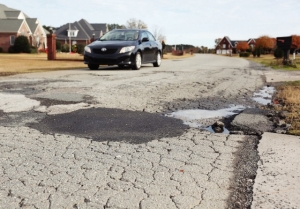Commissioners validate permission to repair streets
By Steve Herring
Published in News on December 4, 2015 1:46 PM

News-Argus/CASEY MOZINGO
A car slows down to drive over a section of potholes and cracks on Stoney Hill Road Thursday.
Wayne County has validated its first petition from subdivision residents seeking the county's help in bringing their streets up to state standards.
But it will still be months before residents find out if that will happen.
The petition is for 10 streets in the Canterbury Village and North Creek subdivisions just north of Goldsboro.
Residents from several subdivisions have appealed to Wayne County commissioners in recent months for help in bringing their deteriorating streets up to state standards so that the state would take them into its road maintenance system.
Commissioners had been discussing using a state law that would allow the county to make the repairs and to then assess property owners.
Under the law a petition must be signed by at least 75 percent of the owners of the property to be assessed and who must represent at least 75 percent of all the lineal feet of frontage of the lands abutting on the street or portion to be improved.
The board voted 6-1 in October to delay any action until the state Department of Transportation completes a statewide assessment next year of subdivision streets and repair costs.
But last month the board adopted a policy hammered out by a working group of Commissioners Joe Daughtery, Wayne Aycock and Joe Gurley that will allow the process to proceed.
The policy limits the issuance of any debt for such projects to not more than $2.5 million in the first two-year cycle.
The policy also sets forth guidelines that commissioners approve projects in the order that the petitions are declared valid and all public hearings have been conducted.
The county will levy a special assessment on all property owners in a subdivision, even if they did not sign the petition, to pay for the work.
The assessment can be spread over a 10-year period. Property owners also have the option of paying their share of the cost in a lump sum in order to avoid paying interest.
County Manager George Wood updated commissioners on the petition during their Tuesday morning session.
Wood said Canterbury Village had 35 buildable lots and North Creek 88 for a total of 123.
"Seventy five percent of 123 buildable lots totaled 93 lots," Wood said. "Next we validated the signatures on the petition, There were valid signatures for 102 buildable lots in the two subdivision. Therefore, it was determined the petition for road improvements in Canterbury Village and North Creek subdivisions was signed by 82.9 percent of the owners of the property to be assessed for the improvements."
Another two signatures have since come in increasing the percentage to 85, he said.
The total lineal feet of frontage represented in the petition accounts for 82.85 percent of the total frontage of all properties represented in the petition, Wood said.
Commissioners will hold two public hearings on each project.
No project may start unless it has been approved by the DOT which must also agree to accept the project street(s) into the secondary highway system for ownership and maintenance once the project has been completed.
"Where we are now we have a meeting scheduled with DOT on the ninth (of December)," Wood said. "That is the earliest we were able to get a meeting with them. Hopefully we will have information back so that on the 15th (of December) we can move forward and start the advertising process on that (public hearing).
"Just to refresh you memory, the first thing that you will do is a notice of a preliminary resolution. Basically what is says is that when you do the preliminary resolution it will have an order setting the time and place for a public hearing."
The hearing cannot be held earlier than three weeks or later than 10 weeks from the date the resolution is adopted.
"So if we are able to work everything out with DOT and have it back to you on the 15th we would schedule the public hearing four weeks from then," Wood said. "So that would put us on the second meeting in January when we would start the process going forward."
A cost estimate would be obtained for the work prior to the second public hearing. At that hearing the residents would know what the assessment would be, Wood said.
Commissioners would decide after the second hearing as to whether to proceed or not, he said.
